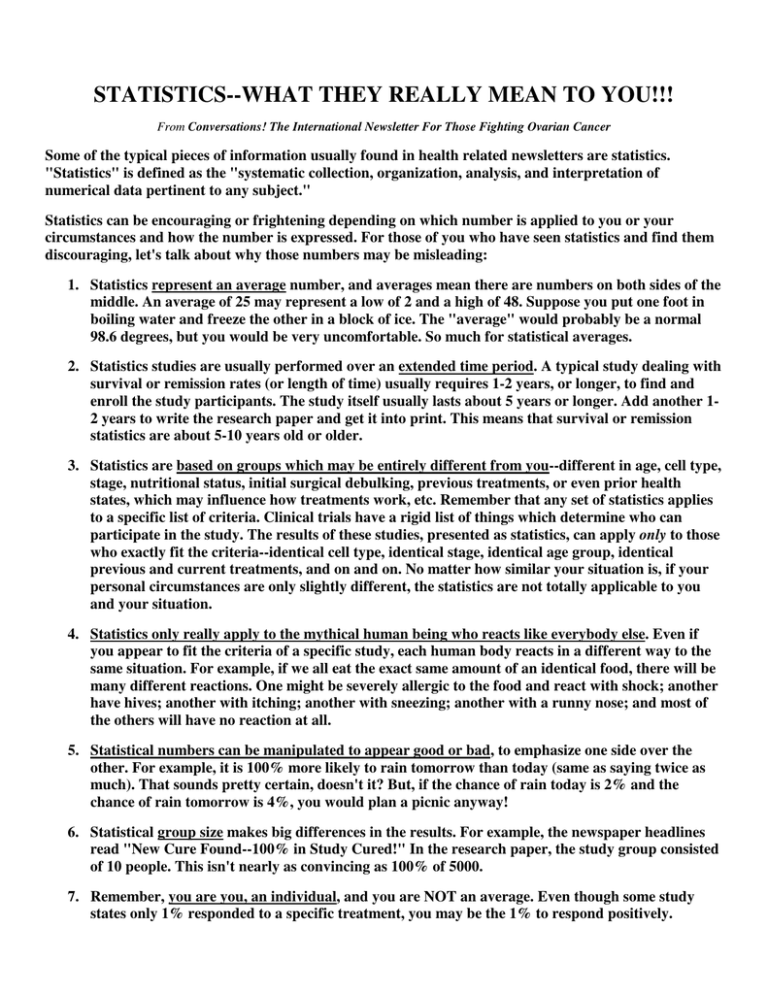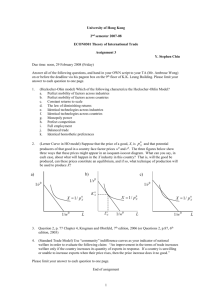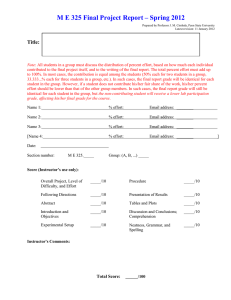
STATISTICS--WHAT THEY REALLY MEAN TO YOU!!!
From Conversations! The International Newsletter For Those Fighting Ovarian Cancer
Some of the typical pieces of information usually found in health related newsletters are statistics.
"Statistics" is defined as the "systematic collection, organization, analysis, and interpretation of
numerical data pertinent to any subject."
Statistics can be encouraging or frightening depending on which number is applied to you or your
circumstances and how the number is expressed. For those of you who have seen statistics and find them
discouraging, let's talk about why those numbers may be misleading:
1. Statistics represent an average number, and averages mean there are numbers on both sides of the
middle. An average of 25 may represent a low of 2 and a high of 48. Suppose you put one foot in
boiling water and freeze the other in a block of ice. The "average" would probably be a normal
98.6 degrees, but you would be very uncomfortable. So much for statistical averages.
2. Statistics studies are usually performed over an extended time period. A typical study dealing with
survival or remission rates (or length of time) usually requires 1-2 years, or longer, to find and
enroll the study participants. The study itself usually lasts about 5 years or longer. Add another 12 years to write the research paper and get it into print. This means that survival or remission
statistics are about 5-10 years old or older.
3. Statistics are based on groups which may be entirely different from you--different in age, cell type,
stage, nutritional status, initial surgical debulking, previous treatments, or even prior health
states, which may influence how treatments work, etc. Remember that any set of statistics applies
to a specific list of criteria. Clinical trials have a rigid list of things which determine who can
participate in the study. The results of these studies, presented as statistics, can apply only to those
who exactly fit the criteria--identical cell type, identical stage, identical age group, identical
previous and current treatments, and on and on. No matter how similar your situation is, if your
personal circumstances are only slightly different, the statistics are not totally applicable to you
and your situation.
4. Statistics only really apply to the mythical human being who reacts like everybody else. Even if
you appear to fit the criteria of a specific study, each human body reacts in a different way to the
same situation. For example, if we all eat the exact same amount of an identical food, there will be
many different reactions. One might be severely allergic to the food and react with shock; another
have hives; another with itching; another with sneezing; another with a runny nose; and most of
the others will have no reaction at all.
5. Statistical numbers can be manipulated to appear good or bad, to emphasize one side over the
other. For example, it is 100% more likely to rain tomorrow than today (same as saying twice as
much). That sounds pretty certain, doesn't it? But, if the chance of rain today is 2% and the
chance of rain tomorrow is 4%, you would plan a picnic anyway!
6. Statistical group size makes big differences in the results. For example, the newspaper headlines
read "New Cure Found--100% in Study Cured!" In the research paper, the study group consisted
of 10 people. This isn't nearly as convincing as 100% of 5000.
7. Remember, you are you, an individual, and you are NOT an average. Even though some study
states only 1% responded to a specific treatment, you may be the 1% to respond positively.
8. Percentages are statements of quantity, but you, as a person, are concerned with the quality of your
individual life.
You are You--YOU are GREATER than any statistic!
Copyright © 1993-2010
CONVERSATIONS! The International Ovarian Cancer Connection
All Rights Reserved. ISSN: 1533-1334




